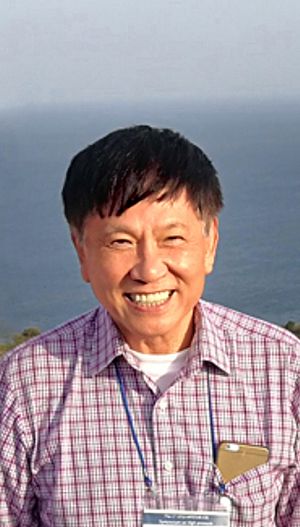Ho-Kwang Mao facts for kids
Quick facts for kids
Ho-Kwang Mao
|
|
|---|---|
 |
|
| Born | June 18, 1941 |
| Alma mater | 1963 B.S. National Taiwan University
1966 M.S. University of Rochester 1968 Ph.D University of Rochester |
| Known for | High Pressure techniques, X-ray sciences |
| Spouse(s) | Agnes Mao |
| Awards | Inge Lehmann Medal (2007) Balzan Prize (2005) |
| Scientific career | |
| Fields | Geology, Material Sciences |
| Institutions | Carnegie Institution of Washington |
| Doctoral advisor | Bill Bassett and Taro Takahashi |
Ho-Kwang (Dave) Mao (Chinese: 毛河光; pinyin: Máo Héguāng; Wade–Giles: Mao Ho-kuang; born June 18, 1941) is a famous Chinese-American geologist. He is known for his amazing work with high pressure. He has helped scientists learn a lot about how materials behave deep inside the Earth. He also directs a big research center in Shanghai, China. Two minerals are even named after him: Davemaoite and Maohokite.
Contents
About Ho-Kwang Mao
Ho-Kwang Mao was born in Shanghai, China, in 1941. When he was seven years old, his family moved to Taiwan. This happened when the government of the Republic of China moved there.
He earned his first degree from National Taiwan University in 1963. Later, he moved to the United States to continue his studies. He received his master's degree in 1966 and his PhD in 1968 from the University of Rochester in New York.
From 1968 to 1972, Dr. Mao worked as a researcher at the Geophysical Laboratory. This lab is part of the Carnegie Institution of Washington. He then spent over 30 years working as a senior scientist there.
In 2013, Dr. Mao started a new research center in Shanghai, China. It is called the Center for High Pressure Science and Technology Advanced Research. He is the director of this center. He leads a team of scientists from around the world. They work together to solve big scientific challenges.
Dr. Mao has three daughters: Cyndy, Linda, and Wendy. His youngest daughter, Wendy Mao, is also a professor. She teaches geological sciences at Stanford University.
Amazing Discoveries in Science
Dr. Mao is a leading scientist in the field of high pressure. This means he studies how materials change under extreme pressure. He has made many important discoveries.
Making and Measuring High Pressure
Dr. Mao is famous for using a tool called the diamond anvil cell. This device uses two tiny diamonds to squeeze materials. It can create incredibly high pressures. He was one of the first to create pressures higher than 1 million times the air pressure at sea level. This was a huge step forward in science.
He also helped develop a way to measure these extreme pressures. This method uses a special light from a ruby crystal. It is now used in almost every diamond anvil cell experiment. His work has been cited by many other scientists.
In 2018, his team reached an amazing pressure of 400 gigapascals. This is about 4 million times the pressure at sea level. They carefully described how they achieved this record pressure.
The Search for Metallic Hydrogen
Dr. Mao has also explored the idea of metallic hydrogen. This is a special form of hydrogen that might act like a metal under very high pressure. He started this research in 1988. He studied the structure of solid hydrogen.
In 2019, his team published new findings. They used X-ray crystallography to study hydrogen. They found that hydrogen changes its electronic structure at very high pressures. This research helps us understand how hydrogen behaves deep inside planets.
Superconductivity Discoveries
In 1987, Dr. Mao and his colleague Robert Hazen made an important discovery. They found a new type of high-temperature superconductor. Superconductors are materials that can carry electricity with no loss of energy. This new material worked at temperatures above the boiling point of liquid nitrogen. This was a big breakthrough.
Iron Peroxide in Earth's Interior
Dr. Mao also discovered how a new material forms deep inside the Earth. This material is called FeO2Hx, or iron peroxide. It forms from common minerals like goethite. It can also form from iron and water under the extreme conditions of Earth's lower mantle.
This new phase can hold different amounts of hydrogen. This is very important for understanding the deep water cycle. It helps us learn how water moves and is stored deep within our planet.
Awards and Recognitions
Dr. Mao has received many awards for his scientific work. Here are some of them:
- 1979: Fellow of the Mineralogical Society of America
- 1979: The Mineralogical Society of America Award
- 1987: Fellow of the American Geophysical Union
- 1989: The P. W. Bridgman Award
- 1990: The Arthur L. Day Prize
- 1993: Member of the United States National Academy of Sciences
- 1994: Academician of the Academia Sinica, Taiwan
- 1994: Fellow of the American Physical Society
- 1996: Foreign Member of the Chinese Academy of Sciences
- 1996: Fellow of the Geochemical Society
- 2002: Chinese government Friendship Award
- 2005: The Balzan Prize for Mineral Physics
- 2005: The Gregori Aminoff Prize
- 2005: The Roebling Medal
- 2007: The Inge Lehmann Medal
- 2008: Foreign Fellow of the Royal Society of London
In 2021, a new mineral was named after him. It is called davemaoite. This mineral is found only in the deep mantle of the Earth. Scientists believe it makes up a significant part of the Earth's lower mantle.

